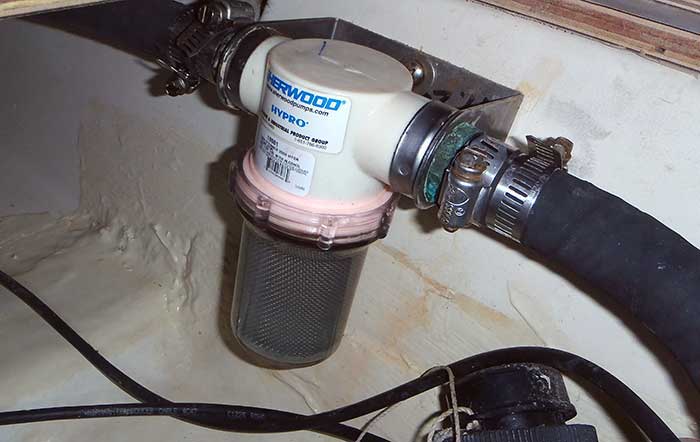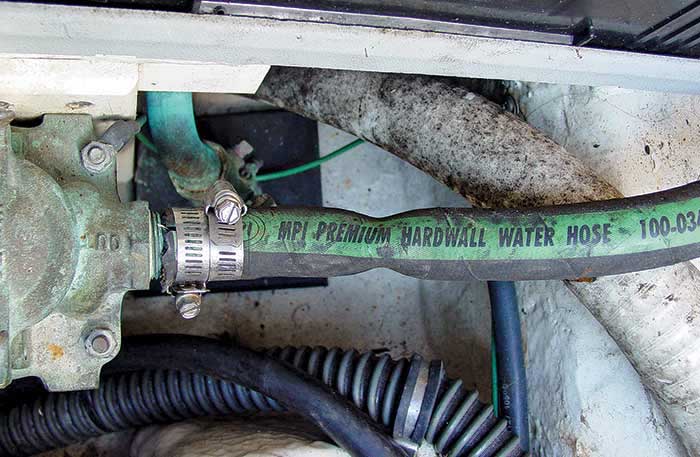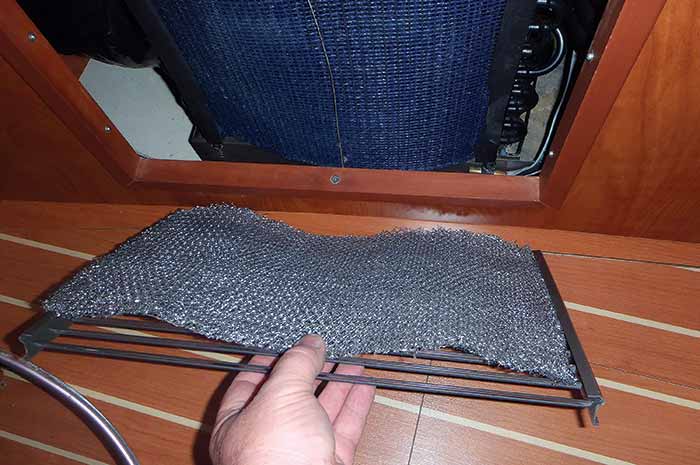Advertisement
If you're lucky enough to have air conditioning on your boat, here's what you need to know about keeping that cold air cranking.

While boating is often about enjoying fresh air on deck, air conditioning can be a real game-changer, especially if you regularly overnight aboard in warmer climates. That said, AC systems are one of those onboard items that rarely get a second thought — until they stop working. Here's how to ensure your system keeps cranking out cool goodness in even the sweatiest of weather.
System Basics
Air conditioning systems come in a wide variety of sizes and configurations. However, they all contain three major components: an evaporator (where “boiling” refrigerant absorbs heat from the air), a compressor (which pushes the refrigerant through the system), and a condenser, where the refrigerant is cooled prior to being returned to the evaporator.
Marine air conditioning units are typically direct expansion designs, which means they pump refrigerant directly to air handlers located in the boat's interior. Larger vessels may instead use a chilled-water system, which cools and circulates cold freshwater through the air handlers instead of refrigerant.
Advertisement
Maintenance
The key to keeping your air conditioner operating reliably is regular maintenance. The first place to look for recommended maintenance is your owner's manual, but here are a few general tips that can be used to help maintain most any AC system.
1. Monitor the water flow. Marine air conditioners work by exchanging heat with circulating seawater. When problems occur, one of the most common causes is lack of water flow through the system. Signs of a saltwater system with restricted water flow can range from a lack of cooling output to increased frequency of on/off cycling of the unit as it struggles to operate.
Monitoring the water flow at the output discharge thru-hull is an easy way to gauge the performance of the raw water-cooling system. Checking the flow of discharge water is something that should be done each time you start your air conditioning system and occasionally during operation.
A discharge that's weak or reduced to a trickle is a sure indication that something's going on, and that something is not good. Most AC systems also incorporate a safety switch that turns off the compressor in the event of insufficient water flow. If you turn on your system and it runs for a bit, then shuts down, it's possible the safety switch has tripped and you need to check the cooling water system for restrictions or blockage. The control panel will also likely display a fault code, which can help narrow down troubleshooting.

2. Regularly check the cooling water intake strainer. The strainer is located between the raw water intake seacock and the unit's pump. Shut off the seacock, then access and inspect the strainer basket, ensuring it's clear of debris and growth. Once the strainer basket is removed, open the seacock briefly to ensure nothing is clogged in front of the strainer. You'll also want to carefully check the strainer basket for damage. The fine, stainless steel mesh baskets found in many A/C strainers can erode rapidly due to the constant flow of water, so keep spares on hand.

3. Check the condition of all hose runs and connections. Begin at the seacock and work your way through the system, from seacock to strainer to pump to air conditioning unit and finally the overboard discharge thru-hull. Look for issues such as leaks, corroded or broken hose clamps, chafe, and collapsed hoses or those showing signs of age or deterioration (such as cracks or swelling at the hose clamps). Seawater cooling hoses should also be double clamped where possible if there is sufficient hose barb to allow it.

4. Shut off the AC when you're not on board. Hose failure is never a good thing, but it can be particularly bad for owners who become complacent about continually running their air conditioning when they're not there. If a raw water cooling hose fails with no one onboard, the continuous pumping of seawater can easily sink a boat. A less dramatic reason to avoid running your air conditioning 24/7 is that the oxygenated seawater produced by this constant flow enables all kinds of marine critters to take up residence and thrive in your cooling system.
5. Periodically flush the condenser coils. Scale can build up on the condenser coils, restricting water flow. The coils should be flushed periodically with a weak solution of biodegradable acid to remove both scale and marine growth, typically every two to five years (depending on where the boat is located and how often the air conditioning is used). Back-flushing the system using dock or pressurized water is another option to try if the system is clogged.

6. Clean the air filters. In addition to cooling water, an air conditioner needs plenty of airflow to perform properly. Good quality, properly fitted air filters are crucial to protecting your AC unit against dirt and dust. Most systems have two air filters: one behind the return air grill and one at the evaporator unit. Air filters should be cleaned monthly as described in the owner's manual, typically by vacuuming or removal and washing with plain water, allowing them to dry thoroughly before reinstalling.

7. Inspect the condensate pan. This is the tray (sometimes two trays) below your air conditioning unit that collects the water (humidity) pulled from the air as it's being cooled. The two things to look for here are proper drainage and corrosion of the pan itself.
The pan should be plumbed so it drains overboard or into a sump, where the water is then pumped overboard. Allowing condensate to drain into the bilge is not recommended. A simple way to check the drain for proper operation is to temporarily plug the drain and pour water into the pan, which should then drain away within about 30 seconds of being unplugged.
If the drain hose is clogged, it can be blown clear with compressed air or pressurized water. If the pan is corroded, particularly to the point it can no longer contain the condensation, it should be repaired or replaced.
8. Check the pressure in chilled-water air conditioning systems. Maintenance requirements for a chilled water air conditioning system are similar to those for a direct-expansion system, however, they must be filled with water to operate properly (similar to refrigerant in a direct expansion system). They will typically have pressure gauges, allowing you to check for leaks or air in the system, which should also be part of your regular maintenance checks.
AC Winterization
Always follow the steps outlined by the manufacturer for winterization of your air conditioning system, such as during your fall layup. However, here are a few general tips for winterizing a typical, raw water-cooled system. Keep in mind that specialized systems (such as a chill water unit) will likely have additional requirements.
- Drain or purge the system of water from the raw water intake seacock to the AC pump (including the raw water strainer).
- Disconnect the hose at the outlet of the AC pump and purge the reminder of the system using compressed air.
- An alternative to the above would be to flush the system with antifreeze. Just be sure that the entire system is protected (e.g., seacock, strainer, pump, and the rest of the AC raw-water plumbing).
